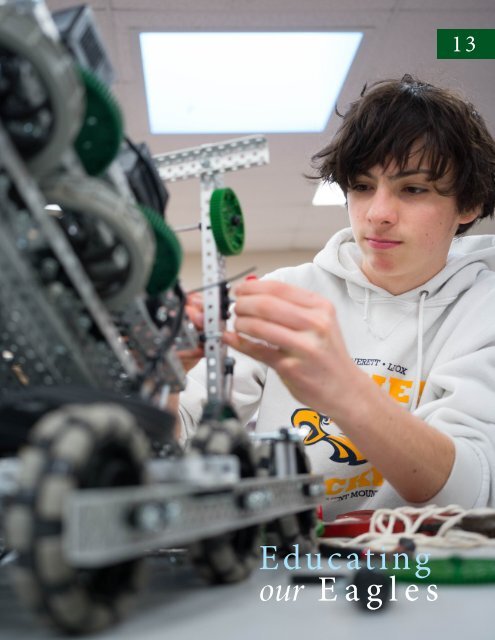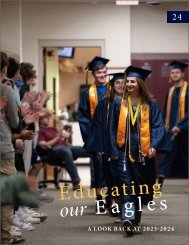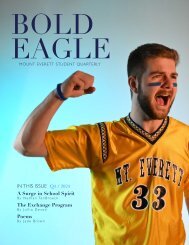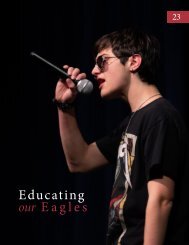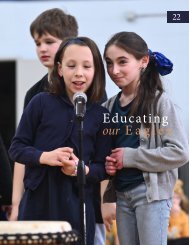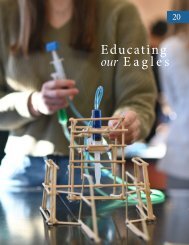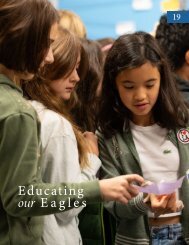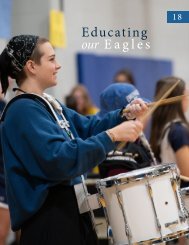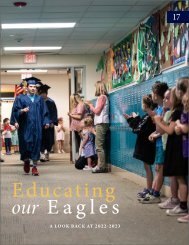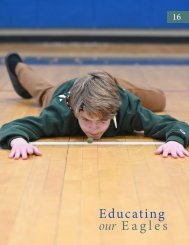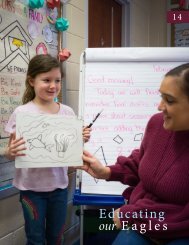Educating Our Eagles - Issue 13
You also want an ePaper? Increase the reach of your titles
YUMPU automatically turns print PDFs into web optimized ePapers that Google loves.
<strong>Educating</strong><br />
our <strong>Eagles</strong><br />
<strong>13</strong>
CONTENTS<br />
4<br />
Introduction - Curriculum Director, Julie Dolan<br />
6<br />
Pre-Kindergarten - Piñata making and breaking – Kim Bleau and Jen Rossi<br />
8<br />
Sixth Grade - Nutrition Poster – Josh King<br />
10<br />
Kindergarten - Building Shapes – Kelly MacDonald<br />
12<br />
High School - Identifying Musical Influence – Alexander Stephen<br />
15<br />
Integrated Pre-K - Penguins – Brenda Vandebogart<br />
16<br />
Tenth Grade - Ser and Estar – Tara Johnston<br />
18<br />
Pre-Kindergarten - Snow Volcano – Kim Bleau<br />
20<br />
First Grade - Owls – Elizabeth O'Donnell<br />
Cover: High Schooler, Tatum works on his Robotics design to<br />
prepare for competition.<br />
Right: Students create electric circuits for their treehouse designs in<br />
8th grade Science.<br />
EDUCATING OUR EAGLES<br />
2
EDUCATING OUR EAGLES<br />
3
INTRODUCTION<br />
From SBRSD’s Director of Curriculum<br />
and Instruction, Julie Dolan<br />
The Department of Elementary and Secondary Education and our<br />
district are committed to all teachers having access to high quality<br />
instructional materials because research shows it can significantly<br />
improve student outcomes. We are dedicated to all students enjoying<br />
the many benefits of a strong curriculum.<br />
• What are curricular materials? Curricular materials are<br />
resources teachers use to facilitate sequences of learning<br />
experiences (e.g., lesson and unit plans, texts)<br />
• What is curriculum? A curriculum is a sequence of student<br />
learning experiences teachers facilitate using curricular materials<br />
as a foundation (not a script!)<br />
In the fall of 2021, we implemented our new Math curriculum in grades<br />
K-8, iReady Math. As a part of this we have provided teachers with<br />
many professional learning opportunities to support their facilitation<br />
of these resources. The results have been positive for students’<br />
engagement and performance.<br />
In the fall of 2022, we implemented a new reading program in grades<br />
6-8, Into Literature, and we are currently selecting High-Quality<br />
Instructional Materials for reading in grades K-5 to be implemented in<br />
the fall of 2023. The process to make this selection began in spring of<br />
2022, and we are now in the last step of our process where we will pilot<br />
materials from two programs.<br />
We have been able to secure grant funding to pay for all our new<br />
curriculum to date and hope to receive another grant this spring that<br />
will cover the costs of our new reading program and the Professional<br />
Development necessary for teachers to be able to implement the<br />
program skillfully.<br />
It is exciting to have access to so many new High-Quality Materials<br />
that ensure our students are exposed to exceptional resources that<br />
have been vetted by experts in these areas based on the most current<br />
research around best practices in education.<br />
If you have any questions about the programs used in our schools, you<br />
can reach me at Jdolan@sbrsd.org.<br />
Right: Kindergarten students practice engineering<br />
as they learn about shapes.<br />
EDUCATING OUR EAGLES<br />
4
5
ELEMENTARY SCHOOL:<br />
Piñata Making and Breaking<br />
As part of the Pre-Kindergarten curriculum, two classes at<br />
Undermountain Elementary worked together to design and create<br />
two piñatas. Once the piñatas were dry, the students decorated them.<br />
The teachers filled them up with goodies and then each student had<br />
a few turns at swinging. Once the piñatas were broken, the class<br />
celebrated with a Ninja bread cookie party!<br />
As a result of instruction, students will be able to:<br />
• learn how to design and create a piñata.<br />
• learn to work together.<br />
• learn about celebrations and cultures.<br />
Observations:<br />
The two classes worked well together. The process took several days to complete. We<br />
read books about the tradition and culture of piñatas. We researched how to make a<br />
piñata and we enjoyed the lesson. We learned to not make it as thick as we did last year<br />
so it was easier to break this year.<br />
MA Standards:<br />
RL PK 1-7,9<br />
PK CC.3<br />
L PK1.g<br />
LPK1d, 5a, c,6<br />
PK G1,2<br />
SLPK.1<br />
RLPK1-7,10<br />
LPK,1<br />
RL PK7<br />
PK MD 1<br />
SL PK1-4 ,6<br />
EDUCATING OUR EAGLES<br />
6
Artist: Rivera, Diego (1886-1957)<br />
Country: Mexico<br />
Date: 1953<br />
Medium and Size: tempera, 96" x 171" (246 x 436 cm)<br />
Museum: Smithsonian American Art Museum, Corbin-Henderson<br />
Collection<br />
EDUCATING OUR EAGLES<br />
7
MIDDLE SCHOOL:<br />
Nutrition Poster<br />
Sixth grade Physical Education students studied nutrition and wellness in class this<br />
past quarter. The class analyzed nutrition labels from their favorite snack or drink<br />
and created a poster showing the nutritional value, nutrition label, and amount of<br />
sugar or salt in their snack.<br />
As a result of instruction, students will be able to:<br />
• read a food label correctly and translate the information onto a poster.<br />
• use measuring and conversation charts to figure out the amount sugar/salt in their snack.<br />
• identify "healthy" snacks based on product rating and make informed decisions about their<br />
health.<br />
Observations:<br />
The students really enjoyed this project because they were able to make connections that<br />
were personal to inform their nutrition choices. They especially enjoyed snacking on their<br />
favorite foods while learning about what might actually be in those snacks.<br />
MA Standards:<br />
PreK–12 Standard 3: Nutrition<br />
Students will gain the knowledge and skills to select a diet that supports health and reduces the<br />
risk of illness and future chronic diseases.<br />
3.9 Describe a healthy diet and adequate physical activity during the adolescent growth spurt<br />
3.10 Describe the components of a nutrition label and how to use the information from labels to<br />
make informed decisions regarding food<br />
EDUCATING OUR EAGLES<br />
8
EDUCATING OUR EAGLES<br />
9
ELEMENTARY SCHOOL:<br />
Building Shapes<br />
Kindergarten students at Undermountain Elementary created their own 2D and 3D shapes<br />
using Play-doh, straws, and toothpicks. The class learned key vocabulary words to identify<br />
shapes and used comparison tools to understand how each shape differs.<br />
As a result of instruction, students will be able to:<br />
• identify 2-D and 3-D shapes.<br />
• compare length of shapes and number of faces.<br />
Observations:<br />
Students enjoyed building their shapes! We first discussed the different types of 3D shapes we learned<br />
about and then began to construct them using various art-making supplies. Later in our unit, we<br />
worked on building 2D shapes. Students spent time discussing how they built their shapes with their<br />
classmates and what they discovered as they built them.<br />
MA Standards:<br />
K.G.B.4. Analyze and compare two- and three-dimensional shapes, in different sizes and orientations,<br />
using informal language to describe their similarities, differences, parts (e.g., number of sides and<br />
vertices/“corners”) and other attributes (e.g., having sides of equal length).<br />
K.G.B.5. Model shapes in the world by building shapes from components (e.g., sticks and clay balls)<br />
and drawing shapes.<br />
EDUCATING OUR EAGLES<br />
10
EDUCATING OUR EAGLES<br />
11
HIGH SCHOOL:<br />
Identifying Musical Influence<br />
Students enrolled in History of Pop Music were asked to choose any song that they<br />
wanted to dive deeper into. They were tasked with completing a musical analysis<br />
of their chosen song and identifying three other influential genres of music that<br />
their chosen artist may have drawn from (as evidenced by a compare/contrast<br />
between their chosen song and another artist from the influential genre of music).<br />
Students were given the option to either complete a paper or a presentation in order to<br />
share their findings with the class.<br />
As a result of instruction, students will be able to:<br />
• utilized their developed musical listening skills and music historical knowledge to<br />
make connections between the influences of different genres of music.<br />
Observations:<br />
All of these students engaged in an analysis in some way. What was surprising, however,<br />
is what the students chose to focus on in their analysis. Not all of the students in this class<br />
identify as musicians. Those who do focused their analysis more on what they heard in the<br />
musical aspects of the song (i.e. instruments, tempo, timbre, etc.), while those who do not<br />
focused on other aesthetic aspects (i.e. lyrics, “vibes”, emotions they associate the song with,<br />
etc.). While I was more expecting the former, the latter was a pleasant surprise that is just as<br />
meaningful an analysis when it comes to diving deeper into music.<br />
MA Standards:<br />
Interpret Intent and Meaning in Artistic Work (F.M.R.08) and Synthesize and Relate<br />
Knowledge and Personal Experiences to Make Art (F.M.Co.10)
EDUCATING OUR EAGLES<br />
<strong>13</strong>
ELEMENTARY SCHOOL:<br />
Penguins<br />
The Integrated Pre-K class at Undermountain<br />
Elementary is learning about penguins of Antartica.<br />
In particular, they are researching their lifestyle (Birds<br />
that don't fly but can swim fast), environment (ocean<br />
and land), and survival strategies (huddling together to<br />
stay warm during brutally cold winter weather).<br />
As a result of instruction, students will be able to:<br />
• complete and create an AB pattern.<br />
• follow two-step directions.<br />
• listen actively to age-appropriate read a-louds and answer<br />
simple questions regarding the book.<br />
Observations:<br />
The children are enjoying this unit. They are making<br />
connections between what they are learning to their own<br />
personal experiences with prompting and support.<br />
MA Standards:<br />
The children will be able to retain and recall information.<br />
The children will listen actively to a read a-loud.<br />
The children will be able to complete and create an AB pattern.<br />
EDUCATING OUR EAGLES<br />
14
EDUCATING OUR EAGLES<br />
15
HIGH SCHOOL:<br />
Ser and Estar<br />
Mnemonic devices: such as acronyms, chunking, and rhymes work by tapping<br />
into how the brain naturally stores data. Students enrolled in Spanish<br />
with Sra. Johnston practice using these tools to help remember the terms<br />
and phrases they study in class. In this lesson, students use the acronyms<br />
DOCTOR and PLACE to help remember when to use the two verbs for “To be” in<br />
Spanish called Ser and Estar.<br />
As a result of instruction, students will be able to:<br />
• memorize and use the verbs Ser and Estar with a variety of topics outlined within the<br />
Acronyms DOCTOR and PLACE.<br />
Ser: Descriptions, Occupations, Characteristics, Time, Origin, Relation<br />
Estar: Position, Location, Action, Condition, Emotion.<br />
Observations:<br />
The students were grateful to have learned the mnemonic devices that allow them to better<br />
understand two very important verbs in Spanish. When comparing the English language to<br />
Spanish, English only has one form of “To Be” whereas Spanish has two main forms of the<br />
verb "To Be". The acronyms for Ser (DOCTOR) and Estar (PLACE) are relatively easy to<br />
remember and give them a way to focus on when to use the verbs.<br />
MA Standards:<br />
ACTFL – World-readiness standards for learning languages:<br />
Communication and Connections.<br />
• Interpersonal Communication: Learners interact and negotiate meaning in spoken, signed,<br />
or written conversations to share information, reactions, feelings, and opinions.<br />
• Interpretive Communication: Learners understand, interpret, and analyze what is heard,<br />
read, or viewed on a variety of topics. (Videos, Lecture and Core practice)<br />
• Making Connections: Learners build, reinforce, and expand their knowledge of other<br />
disciplines while using the language to develop critical thinking and to solve problems<br />
creatively. (Lecture, Cultural comparison, Literary comparison, Core practice)<br />
EDUCATING OUR EAGLES<br />
16
EDUCATING OUR EAGLES<br />
17
ELEMENTARY SCHOOL:<br />
Snow volcano<br />
With the use of baking soda, food coloring, and vinegar, Ms. Bleau’s prekindergarten<br />
students explored reactions through volcanos, color, and snow!<br />
The class created a volcano with the added bonus of coloring the surrounding<br />
snow. The class discussed how the ingredients they used would mix together and what<br />
type of reaction would occur. They were excited to watch as the liquid bubbled over to<br />
color the snow!<br />
As a result of instruction, students will be able to:<br />
• observe a science experiment and understand what a reaction is.<br />
• observe color theory in action.<br />
Observations:<br />
As the class continued to add more baking soda and vinegar to the experiment, the various<br />
colors mixed together. Yellow and blue made green, red and blue made purple. The students<br />
were excited to watch the process and reaction in real time and learned about color theory and<br />
science while havng a lot of fun!<br />
MA Standards:<br />
PS1-4<br />
EDUCATING OUR EAGLES<br />
18
EDUCATING OUR EAGLES<br />
19
ELEMENTARY SCHOOL:<br />
First Grade Owls<br />
First grade students at New Marlborough Central started their lesson reading a Scholastic News titled<br />
Nocturnal Animals. Students continued their learning by studying an owl of their choice and completing<br />
guided research on iPads to learn facts about their chosen owl. Students wrote Acrostic Poems that<br />
included facts from their research.<br />
As a result of instruction, students will be able to:<br />
• use iPads to conduct research.<br />
• write Acrostic Poems including facts from research.<br />
Observations:<br />
The students were eager to use iPads for guided research. The students were successful in learning facts from their<br />
research on their chosen owl. In addition, students learned facts about owls from peers sharing their research about<br />
other species of owls.<br />
MA Standards:<br />
Reading Standards for Informational Text<br />
5. Know and use various text features (e.g., headings, tables of contents, glossaries, electronic menus, icons) to locate<br />
key facts or information in a text.<br />
Range of Reading and Level of Text Complexity<br />
10. With prompting and support, read and comprehend informational texts exhibiting complexity appropriate for at<br />
least grade 1.<br />
Research to Build and Present Knowledge<br />
7. Participate in shared research and writing projects<br />
EDUCATING OUR EAGLES<br />
20
EDUCATING OUR EAGLES<br />
21
EDUCATING OUR EAGLES<br />
22


